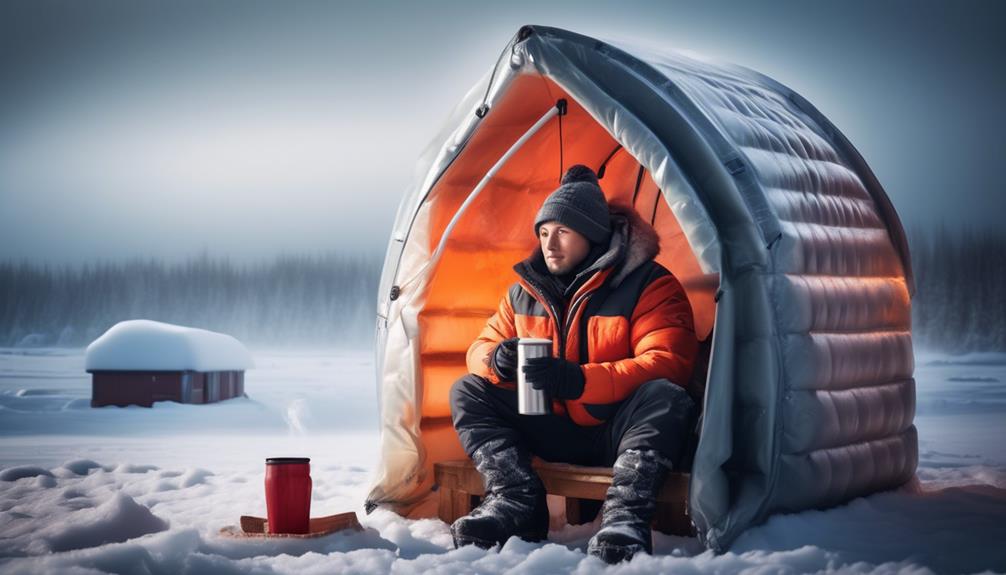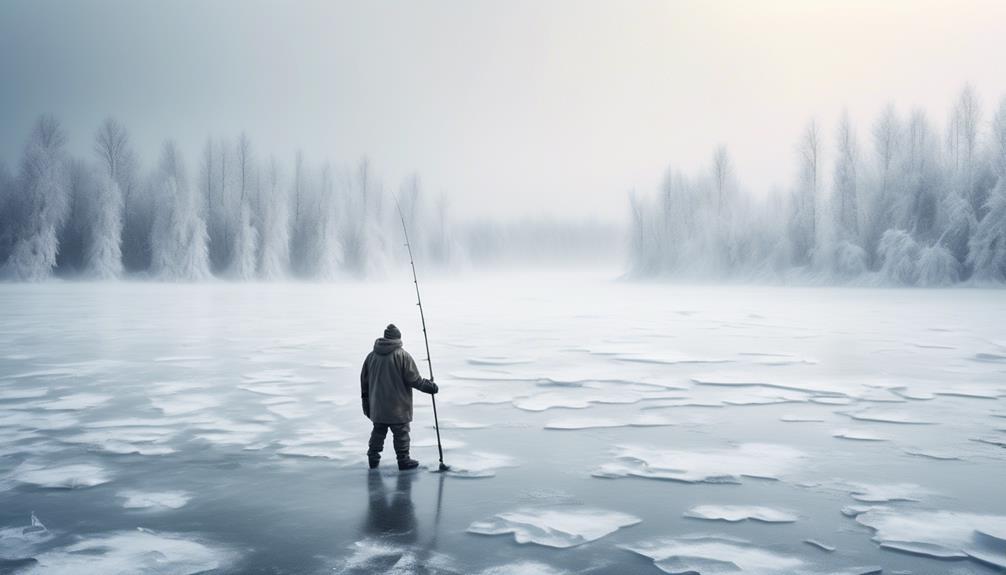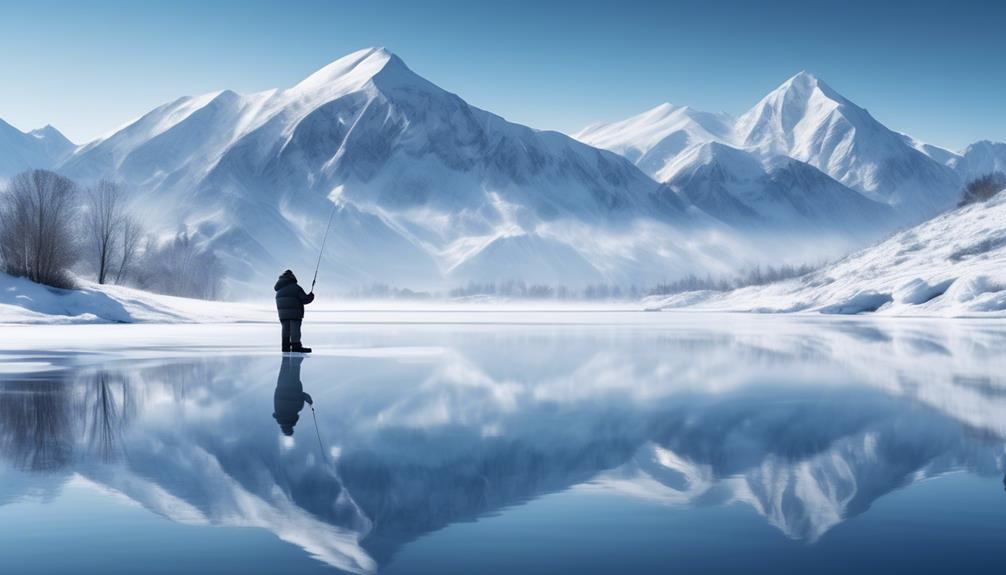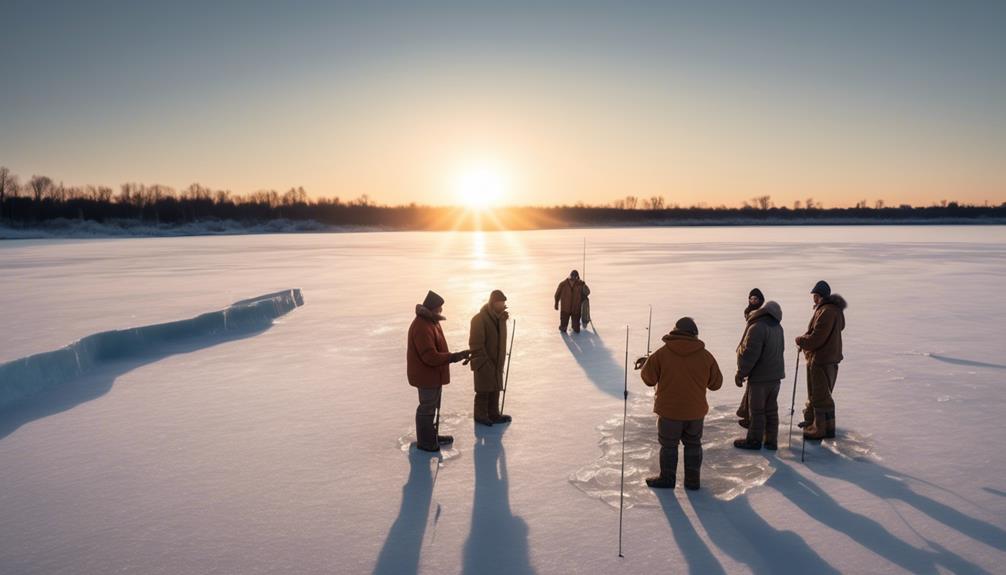When it comes to ice fishing in extreme weather, it's like venturing into the heart of a blizzard to find a hidden treasure.
The allure of testing your skills and resilience against nature's harshest conditions is a challenge that many anglers find irresistible.
But why subject yourself to such extreme circumstances? Well, there are some unexpected benefits and unique opportunities that come with braving the cold, and understanding them might just change your perspective on this unconventional sport.
Benefits of Ice Fishing in Extreme Weather
When ice fishing in extreme weather, you'll experience the thrill of facing nature's elements while reaping the rewards of a peaceful and undisturbed fishing environment. Despite the challenges, there are numerous benefits to braving the cold for this unique fishing experience.
One of the key advantages is the solitude and tranquility that come with extreme weather ice fishing. The harsh conditions often deter casual anglers, leaving dedicated enthusiasts with the entire frozen expanse to themselves. This not only provides a sense of serenity but also increases the likelihood of a successful catch due to reduced competition.
Moreover, extreme weather ice fishing presents an opportunity to connect with nature in its rawest form. The stunning, snow-covered surroundings and the crisp, cold air create an invigorating atmosphere that's unparalleled. There's a sense of accomplishment in overcoming the obstacles that come with fishing in such conditions, fostering a deep appreciation for the natural world.
Additionally, the extreme cold can lead to the formation of clearer ice, offering a better visibility of the aquatic life below. This, combined with the reduced human activity, can result in larger and more active fish, making the endeavor even more rewarding.
The challenges of extreme weather ice fishing are undeniably daunting, but the benefits of a peaceful, undisturbed environment and the potential for a bountiful catch make it an experience worth pursuing.
Safety Tips for Ice Fishing in Extreme Conditions
Braving extreme weather conditions for ice fishing offers a unique and rewarding experience, but ensuring your safety in such harsh environments is paramount. Here are some essential safety tips to keep in mind:
- Emergency Communication and Survival Skills
Always carry a fully charged cell phone and a portable charger in a waterproof bag. Additionally, consider investing in a personal locator beacon or satellite messenger for remote locations. Equip yourself with basic survival skills such as building a shelter, starting a fire, and signaling for help. These skills can be crucial in unforeseen circumstances.
- Hypothermia Prevention and First Aid Techniques
Dress in layers to maintain body heat and wear moisture-wicking clothing to stay dry. Familiarize yourself with the symptoms of hypothermia and know how to respond effectively. Keep a first aid kit on hand with essentials such as bandages, antiseptic wipes, and thermal blankets. In the event of an emergency, knowing how to administer basic first aid can make a significant difference.
- Safety in Numbers
Whenever possible, avoid ice fishing alone. Having a buddy or a group not only enhances the experience but also serves as a safety precaution. In case of an accident, having someone to assist or seek help can be lifesaving.
Essential Gear for Extreme Weather Ice Fishing
To ensure your safety and comfort during extreme weather ice fishing, having the right gear is essential. When facing harsh conditions, proper gear can make all the difference.
Firstly, maintaining your gear is crucial. Before heading out, check your ice fishing equipment thoroughly. Make sure your ice auger is sharp and in good working condition, your ice shelter is sturdy and free of any damage, and your ice fishing rods and reels are well-lubricated. Cold temperatures can cause malfunctions, so taking the time to maintain your gear beforehand is vital.
Additionally, understanding fish behavior is key. In extreme weather, fish tend to be more lethargic and may require different bait presentations. Therefore, having a range of bait options and adjusting your techniques based on the fish's behavior can significantly improve your chances of a successful catch.
Furthermore, investing in high-quality cold-weather gear is a must. Insulated waterproof boots, thermal socks, layered clothing, waterproof gloves, and a windproof jacket are essential for staying warm and dry.
Lastly, carrying safety gear such as ice picks, a floatation device, and a fully charged communication device can potentially save your life in case of an emergency. By being prepared with the right gear and taking the time to maintain it, you can enjoy ice fishing in extreme weather conditions while staying safe and comfortable.
Techniques for Catching Fish in Harsh Weather
In harsh weather conditions, adapting your fishing techniques is crucial for increasing your chances of catching fish. When ice fishing in extreme weather, it's essential to modify your approach to suit the conditions. Here are some ice fishing techniques and cold weather fishing strategies to help you reel in the big ones:
- Use Sensitive Equipment: In extremely cold weather, fish are less active and more sluggish. Using sensitive equipment such as a spring bobber or a light action rod can help detect the subtle bites. This will improve your ability to hook the fish, despite the slow movements caused by the frigid temperatures.
- Experiment with Different Baits: In harsh weather conditions, fish may be more selective about their food. Try using a variety of baits to see which ones are most effective. Small jigs, live bait, or soft plastics can entice fish in cold water, increasing your chances of a successful catch.
- Stay Mobile: When the weather is severe, it's important to stay on the move to find active fish. Drill multiple holes and move around until you locate a productive spot. Being mobile allows you to cover more area and find the fish that are willing to bite despite the challenging conditions.
Preparing for Extreme Weather Ice Fishing
Preparing for extreme weather ice fishing requires careful consideration of safety measures, equipment maintenance, and strategic planning to ensure a successful and enjoyable experience on the ice.
When facing extreme cold, layering clothing is crucial. Start with a moisture-wicking base layer to keep sweat away from your skin. Add an insulating layer to retain body heat, and finish with a waterproof and windproof outer layer to shield you from the elements. It's essential to regulate your body temperature to prevent hypothermia, so adjust your layers as needed throughout the day.
Staying hydrated is equally important. Cold weather can mask the signs of dehydration, so be proactive about drinking water. Hydration packs are convenient for ice fishing, providing easy access to fluids without having to remove gloves in freezing conditions. Consider packing warm beverages like tea or hot chocolate in a thermos to help maintain your body temperature while also staying hydrated.
Additionally, keep an eye on your companions to ensure they're also taking these measures seriously.
Finding the Best Locations for Extreme Weather Ice Fishing
When seeking out the best locations for extreme weather ice fishing, consider the depth and clarity of the ice, as well as the presence of underwater structures and currents. Here are three key factors to keep in mind:
- Ice Fishing Hotspots: Look for areas that are known as ice fishing hotspots, where fish are abundant and the ice is thick and stable. These hotspots are often well-visited and have a reputation for yielding good catches. Additionally, local fishing clubs or forums can provide valuable insights into the best locations for extreme weather ice fishing, as experienced anglers often share their knowledge and tips for finding the most productive spots.
- Extreme Weather Preparation: Identify locations that offer natural protection from extreme weather conditions, such as strong winds or heavy snowfall. Areas with natural windbreaks, such as cliffs or dense forests, can provide shelter and make your ice fishing experience more comfortable and safer. Moreover, consider the accessibility of the location during extreme weather. Ensure that the chosen spot is reachable even in harsh conditions, and plan your route carefully to avoid getting stranded due to snowdrifts or icy roads.
- Underwater Structures and Currents: Explore areas with underwater structures, such as rock formations or submerged trees, as they often attract fish seeking shelter and food. Additionally, understanding the underwater currents can help you locate the best fishing spots. Look for areas where the currents are slower, as these are often favored by fish for feeding and resting.
Maintaining Comfort and Warmth While Ice Fishing

Considering the harsh conditions you may encounter while ice fishing in extreme weather, ensuring your comfort and warmth becomes paramount for a successful and enjoyable experience. Maintaining warmth is crucial to avoid hypothermia and maximize your time on the ice. Layering techniques are essential for regulating body temperature and staying comfortable during long hours outdoors.
Start with a moisture-wicking base layer to keep sweat away from your skin. Synthetic materials such as polyester or merino wool are great choices. Over this, add an insulating layer like fleece or down to trap body heat. Finally, top it off with a waterproof and windproof outer shell to protect against the elements.
Remember to dress in loose-fitting layers to allow for better air circulation, as tight clothing can restrict blood flow and make you feel colder. Don't forget to protect your extremities by wearing thick socks, insulated waterproof boots, gloves, and a well-insulated hat or beanie. Hand and foot warmers can also provide additional comfort in freezing temperatures.
Additionally, it's crucial to stay dry to maintain warmth. Pack extra clothing in case you get wet, and consider investing in a portable shelter to shield yourself from harsh winds and blowing snow.
Challenges of Ice Fishing in Extreme Weather
Navigating through treacherous ice, bone-chilling winds, and limited visibility presents significant challenges for ice fishing in extreme weather. The harsh conditions demand mental toughness, perseverance, physical endurance, and adaptation.
Here are the main challenges you face when ice fishing in extreme weather:
- Mental Toughness and Perseverance: Enduring extreme cold, biting winds, and the isolating nature of the frozen landscape can be mentally draining. The constant battle against the elements requires unwavering determination and the ability to stay focused even when conditions are at their most brutal. Keeping a positive mindset and staying motivated despite the adversity is crucial for a successful ice fishing experience.
- Physical Endurance and Adaptation: The physical demands of ice fishing in extreme weather shouldn't be underestimated. Your body must withstand the frigid temperatures, often for prolonged periods. Additionally, the need to adapt to the constantly changing environment, such as shifting ice conditions and fluctuating winds, requires physical resilience and flexibility. It's essential to be prepared for the physical strain and to maintain your energy levels to ensure safety and productivity on the ice.
Ice fishing in extreme weather requires mental fortitude, unwavering perseverance, physical resilience, and the ability to adapt to the ever-changing conditions. Understanding and preparing for these challenges are vital for a successful and enjoyable ice fishing experience.
Frequently Asked Questions
Can You Ice Fish in Extreme Weather Without Specialized Gear?
You can ice fish in extreme weather without specialized gear, but it's risky. To ensure safety, it's essential to have the right gear for extreme conditions, take necessary precautions, and be aware of potential dangers.
What Are the Risks of Ice Fishing in Extreme Weather?
When ice fishing in extreme weather, risks include hypothermia and falling through thin ice. Take precautions by checking ice thickness, wearing appropriate gear, and having an emergency response plan. Safety measures and specialized gear are essential for hypothermia prevention.
How Do You Stay Safe From Hypothermia While Ice Fishing in Extreme Conditions?
To stay safe from hypothermia while ice fishing in extreme conditions, make sure you have emergency supplies, wear proper clothing, seek shelter, stay dry, conserve body heat, and know how to prevent hypothermia.
Are There Any Specific Techniques for Ice Fishing in Extreme Weather?
When ice fishing in extreme weather, it's essential to prepare for the harsh conditions. Utilize specific ice fishing techniques like using insulated shelters, dressing in layers, and employing portable heaters to stay safe and comfortable.
What Are the Signs of Dangerous Ice Conditions and How Can You Avoid Them?
Recognizing signs of dangerous ice conditions is crucial for safety. Look for cracks, slush, or discoloration. Avoid dangers by checking ice thickness with a spud or auger and choosing safe routes along shorelines or areas with less snow cover.
Conclusion
So, next time you're thinking about ice fishing, don't let extreme weather hold you back.
With the right gear, techniques, and preparation, you can still enjoy a successful and thrilling ice fishing experience in harsh conditions.
Stay safe, stay warm, and embrace the challenges of ice fishing in extreme weather for an unforgettable adventure on the ice.



